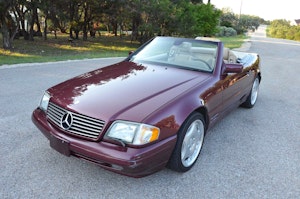Media | Articles
2025 Porsche 911 GT3: Track-Ready or Touring, the 25-Year Party Rolls On
It’s a Teutonic two-fer to celebrate the 25th anniversary of one of Porsche’s most enthusiast-oriented models, the 911 GT3. Two distinct variants of the new GT3 bowed today, each ruthlessly focused on driver engagement and enjoyment.

Monied Porsche fans can have their 911 GT3 in one of two flavors: a track-oriented version, simply dubbed the 911 GT3, or a more subtle, road-going version, the now-familiar 911 GT3 with Touring Package. That name gets a little clunky, so we’ll join the throngs of folks who simply call it the “911 GT3 Touring” for the rest of this piece.

Central to the GT3 experience is the car’s sonorous flat-six engine. While other 911s are going turbocharged or even hybrid, the 911 GT3 will soldier on with a naturally aspirated engine displacing four liters and making 502 hp and 331 lb-ft of torque. The displacement and horsepower figures carry over from the previous model, but the torque drops 15 lb-ft, down from 346. Updates include a new camshaft profile, cribbed from the track-slaying 911 GT3 RS, new cylinder heads, new butterfly valves for the individual throttle bodies, and new oil coolers.
Both versions of the new GT3 can be had with either a seven-speed PDK dual-clutch automatic or a six-speed manual transmission. Regardless of pedal count, the final drive ratio of the new 911 GT3 has been shortened by eight percent.


Though it also looks quite similar to the previous model, there are a few subtle design tweaks. A redesigned front diffuser and modified underbody air guides better manage the atmosphere flowing over and under the car at speed. Out back, there’s a new rear diffuser and revised air inlets. Thanks to a new front headlamp design that can handle all lighting functions, there are no longer small LED light bars low down on the car’s nose. Eliminating those little lights allowed Porsche engineers to enlarge the air inlet area on the GT3’s front fascia.
Marketplace
Buy and sell classics with confidence

Porsche’s GT cars are famous for slowly cribbing engineering tricks from the models above them, and the new GT3 is no different. Special teardrop-shaped trailing arms on the front axle increase high-speed downforce and improve brake cooling. The front ball joint on the lower trailing arm sits lower on the front axle, helping to reduce how much the nose pitches under hard braking. Both modifications come directly from the 911 GT3 RS.
As is often the case, Porsche engineers also found a few excess pounds to shave off the new model. New aluminum forged wheels reduce unsprung mass by 3.3 lbs, and a new lightweight lithium-ion battery saves another 9.9 lbs over the previous model.

The normal 911 GT3 features more obvious nods to track performance, the obvious one being that large wing out back. There’s a new Weissach package, something originally only offered on the even gnarlier RS version of the 911 GT3. Opt for that equipment group, and you’ll get heaps of lightweight, carbon-fiber-reinforced plastic (CRFP) parts, including the roof, rear wing side plates, exterior side mirror shells, anti-roll bar, and more. You’ll also get a mix of leather and Race-tex (a matte-finish, Alcantara-like material) inside. Notably, the upper dashboard will be swathed in Race-Tex to reduce glare if you’re ripping directly toward the sun on track. For the ultimate lightweight GT3, customers can also spec Magnesium wheels to save an additional 20 lbs.

If you’d rather ambush unobservant passers-by with a 9000-rpm zing, the understated 911 GT3 Touring might be more your speed. This model does away with the fixed rear wing, preserving the classic 911 silhouette. Instead, the GT3 Touring gets an active rear spoiler with a gurney flap and trim-specific underbody air guide to manage the downforce.
This version also gets a more upscale interior with more leather choices, and now, thanks to repeated customer requests from the previous generation, you can spec a 911 GT3 Touring with rear seats.


Lest you think a GT3 Touring becomes the porker of the family, there’s a new “Leichtbau” (Lightweight) package on offer, too. Ticking that box will get the same CRFP anti-roll bar, coupling rods, and rear axle shear panel as the normal GT3 with the Weissach package, and here, the CRFP roof will be painted to match your GT3 Touring’s body color. Magnesium wheels and lighter door panels are part of the spec, too. Option your ride with the six-speed manual and the Lightweight package, and you’ll get the shortened gear lever from the 911 S/T—a limited-run, 911 GT3 RS shorn of all its track-bending aero kit. (Talk about a tiny nod to the true GT sickos; we love it.)
Inside both versions, there’s a new optional lightweight bucket seat with a CRFP shell and a folding backrest. The seat still features electronic height adjustment and a thorax airbag, but fore/aft adjustment goes back to manual, probably in the interest of weight savings. Here’s a neat bit: Part of that seat’s headrest padding can be removed to better accommodate a driver wearing a helmet while on track.

While 911 Carrera models have all converted to push-button ignition, the GT3 retains a rotary switch, which feels like a tasteful nod to the past. The digital instrument cluster, very much a thing of the future, can be whittled down to just vital driving data (tires, oil, water, and fuel) with a display mode called “Track Screen.” Perhaps our favorite little detail of the new car: The driver can rotate how the tachometer reads in the center dial so that the 9K-rpm redline appears at the 12 o’clock position, as you’d see in old race cars.

“The new 911 GT3 has become even more exhilarating and individual. We dug into a wealth of details and gave it many features that our customers wanted. This allows the GT3 to be adapted even more specifically to the purpose or preferences of the driver,” said Andreas Preuninger, head of Porsche’s GT car division.
And so it shall. We’ve loved every moment behind the wheel of previous 911 GT3s, and there’s no reason to think this one will be any different. It will, however, be a bit pricier. The 2025 911 GT3 has a starting MSRP of $224,495, including a $1995 destination fee. Gulp. That’s a fair sum pricier than the outgoing model, which started around $185K. Still, this sort of driving nirvana doesn’t come cheap, and frankly, the folks prepping to call their dealers and place a deposit won’t be deterred. Orders will begin at the end of this year, with the first examples reaching U.S. shores next summer.












































Amazing cars. I love the touring option, but I admit I want the big wing for some reason.
Touring, please (as he checks lottery ticket)!